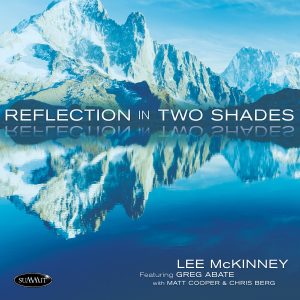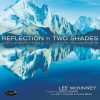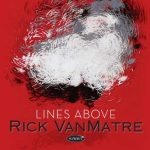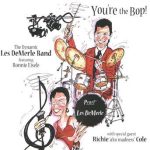“Featuring critically acclaimed saxophonist Greg Abate, this recording, driven by McKinney’s tunes, drums and leadership, is world-class original jazz.”
Lee McKinney, a talented and versatile jazz drummer, is based in Yellow Springs, Ohio, a half-hour east of Dayton and an hour away from both Cincinnati and Columbus. He recalls how he got started: “When I was a kid, I heard drummers on the Ed Sullivan Show and I always loved the sound of a good snare drum. When I was in the fifth grade my parents rented me a snare drum kit, I was soon in the band in school and, by the time I was a freshman in high school, I decided that I wanted to see if I could make a career out of playing drums.”
Lee has succeeded at his goal, uplifting a countless number of groups through the years. Most notable among his associations was working with veteran saxophonist Norris Turney who was with Duke Ellington’s orchestra during 1969-73. “Art Blakey, Philly Joe Jones and Max Roach are the three drummers who have had the strongest influences on my playing. Their styles of playing have seeped into what I play.” He pays tribute to all three masters during various selections on his new album.
Reflections In Two Shades is a major step forward in Lee McKinney’s career for it not only has him playing drums in a world-class quartet but it features his compositions. “I’ve had it in the back of my mind for a long time that I wanted to make a CD of all-original material. These songs were written over a long period of time. In fact, while some are new, a couple were originally assignments in composition class in college that I’ve updated.” For the notable project, Lee was particularly happy to have the great altoist Greg Abate aboard. “Greg and I have been friends for over 20 years and he is a masterful player on all of his instruments. A piano friend of mine from Oregon, Matt Cooper, was my first choice and was fortunately available. He was actually a teacher of mine during my senior year in college. And I was also lucky enough to get one of the best bass players in this area, Chris Berg.”
—————
“I received the CD and had a chance to listen to it – sounds great! Nice tunes too, I particularly enjoyed your bossa “A Living Doll”. I hope the album receives good attention, very nice playing from everyone.”
-Behn Gillece, 2018 Downbeat Critics Poll Rising Star Vibraphone
With the release of the enjoyable “Reflections in Two Shades”, Lee McKinney deserves to be recognized not just as a swinging jazz drummer but as a skilled songwriter and band leader.
-Scott Yanow, Jazz Journalist / Historian
—————
REVIEW:
…a winning release that is consistently interesting.
-Jersey Jazz
I confess that I’m always just slightly leery of drummer-led jazz combos. Not because there aren’t tons of jazz drummers I really admire, but because I find drum solos tiresome. So the great news about this new quartet album led by drummer/composer Lee McKinney is that the drum solos are no more numerous or long than they would be on any other quartet date. Instead of a drum-centric album, what we have is a rock-solid set of original compositions played with that elusive blend of tightness and swinging looseness that every jazz combo seeks and so few find. McKinney is not only a powerfully swinging drummer; he’s also a truly gifted composer, and these tunes — each of which is presented as a dedication to a friend or musical inspiration — are both original and straight-ahead in style. The brilliant reedman Greg Abate alternates between alto sax, soprano sax, and flute, and pianist Matt Cooper and bassist Chris Berg contribute no less value. This is a tremendously enjoyable and brilliantly executed album.
-CD HOTLIST
REVIEW:
Drummer Lee McKinney has a nifty new album out. It features Lee on drums with Greg Abate (one of the most gifted alto and soprano saxophonists recording today), the plush Matt Cooper on piano and Chris Berg on bass. Lee, who is based in Yellow Springs, Ohio, and gigs in Dayton, sounds as if he lives in Brooklyn. He’s a terrific polyrythmic player with a tender intensity. He’s also a solid composer. Best of all, the album swings.
-JazzWax
REVIEW:
Drummer Lee McKinney leads a bopping quartet of Matt Cooper/p, Chris Berg/b and Greg Abate/as-ss-fl on this confident collection of hard bop-styled originals. McKinney’s drums serve as a strong frame for these portraits, dedicated to the likes of drummers such as Art Blakey, Max Roach and Philly Joe Jones, as well as other inspirations.
With Abate’s Phil Woods-hinted alto, McKinney and company sizzle on “The Jazz Messenger”, while the team bops till it drops on “Bird’s Eye View, with McKinney and Berg as crisp as snow peas. The sticks give a nifty intro to “Lenwood” before Berg gets some solo space, and the brushes assuage the graceful “Rebecca”. Abate’s soprano is sweet around the Latin lilt of “A Living Doll” as Cooper’s ivories chime and charm, and his flute glides over the Brazilian “Samba De La Vamos Nos” like a hawk. Cool shades of heat.
-George Harris for Jazz Weekly
REVIEW:
“Reflection in Two Shades” celebrates a major step forward in Lee McKinney’s career. He not only plays drums, but he has composed all the songs, beginning with “A Shade of Jade” that is both melodic and energetic. Greg Abate on alto saxophone takes off on an improvised solo that is brilliant. Afterwards, Lee McKinney enters with a stellar drum solo that elevates the moment. This song sounds like a jazz standard and the quartet plays it with passion.
“I’ve had it in the back of my mind for a long time that I wanted to make a CD of all-original material. These songs were written over a long period of time. …some are new,” McKinney shares in his press package.
I think it’s so impressive to hear such well-structured songs coming from a drummer. Track #2 is titled “A Living Doll.” That’s an old saying from the forties that described a good-looking female. Today it might be referring to an A1 character. Times have changed, but the music Lee McKinney offers us is timeless. His tunes are true to the bebop era, but also, (like this one), steeped in Latin flavor and more modern. Matt Cooper steps forward on piano during the arrangement of “A Living Doll” and shows off his mad technique and inspired creativity.
“A piano friend of mine from Oregon, Matt Cooper, was my first choice and was fortunately available. He was actually a teacher of mine during my senior year in college,” McKinney sings his praises about his friend and pianist who he contracted for this project.
His tune, “Lenwood” is another Straight-ahead gem, sparkling under the guidance of these excellent musicians. Greg Abate is masterful on his alto horn and after establishing the melody, veers into the atmosphere to improvise. I was happy to hear Chris Berg stretch out on his double bass and play a brief, but innovative solo before Lee McKinney entered on his trap drums, offering a flurry of drum licks and technique. On “The Bebop Vampire” the quartet picks the tempo up, spreading wings and flying across my listening room. I cannot say enough about these wonderful compositions penned by McKinney. His melodic mastery is on display as well as his awesome drum talents. I enjoyed it when the band traded fours with the bandleader and let us soak up his juicy percussive talents during this arrangement. He flips the coin on a tune called “Rebecca” and shows us his tender side. During this ballad, I am reminded of Thelonious Monk’s writing. Every song on this album is well-executed and brilliantly written. “Bird’s Eye View” is absolutely a tribute tune to the great Charlie Parker. I could listen to Lee McKinney’s music all day and never get bored.
-Dee Dee McNeil for Making A Scene
REVIEW:
Lee McKinney’s New Album Will Appeal To A Wide Range Of Jazz Fans
Late this past March, percussionist and drummer Lee McKinney released his new album, Reflection in Two Shades through Summit Records. The nine-song record, which runs just under an hour, (McKinney’s second behind his then most recent recod, Celebrating Larry Young) is an enjoyable offering for any jazz fan. Each of its featured arrangements make that clear, not the least of which being ‘Rebecca,’ which serves as the record’s midpoint. The song, which expertly breaks up the record, will be examined shortly. ‘Samba De La Vamos Nos.’ This addition to the record will be discussed a little later. ‘Lenwood,’ which comes earlier in the album’s run, is another welcome addition to the album and will also be discussed later. Each track noted here plays its own crucial part to the record’s overall presentation. When they are considered alongside the rest of the album’s entries, the whole makes the album overall, a welcome addition to this year’s already crowded field of new jazz albums.
Reflection in Two Shades, the latest studio offering from Berklee College of Music-educated percussionist and drummer Lee McKinney, is an enjoyable presentation that most jazz fans will appreciate. All nine of the songs that make up its 53-minute body make that clear, not the last of which being its midpoint, ‘Rebecca.’ According to the album’s liner notes, McKinney composed the song as a tribute to his daughter. The gentle, flowing ballad of sorts is a wonderful way for McKinney to break up the album considering the energy presented throughout the rest of the record. His gentle use of the brushes is such a great subtle mark on the arrangement as acclaimed saxophonist Greg Abate leads the way with just enough controlled energy as the group makes its way through the song. Matt Copper virtually glides along the keys as he performs on piano while bassist Chris Berg puts just the right touch to the foundation to make the whole complete. The quartet’s gentle composition flows like such a loving tribute to McKinney’s daughter that any parent will appreciate just as much as any jazz fan.
Changing things up even more immediately after that song is a work that, according to the album’s liner notes, is a tribute to another even more famous percussionist, Airto Moreira. The incorporation of the flute line alongside the clearly Afro-Latin style drumming from McKinney here makes the comparison immediately clear. Listeners can instantly hear a comparison to the likes of Moreira’s ‘Rhythms and Colors.’ In the same vein, one cannot help but wonder if Moreira played any influence in the works of yet another famed composer, one Vince Guaraldi. Coincidence or not, this entry is another change of style and sound that jazz fans are sure to enjoy, further showing how much this album has to offer.
One more notable addition to the album is the early entry, ‘Lenwood.’ As with the other examined works, this song also changes things up in its own right. This time, McKinney and company offer audiences a hard bop composition that throws back to some of the great works from John Coltrane. This despite the liner notes stating the composition was inspired by another saxophonist, Jackie McLean. That distinct stylistic approach from McLean is notable in the likes of ‘’Das Dat’ and to a slightly lesser degree on ‘Stable Mates,’ from McLean’s 1960 album, Swing, Swang, Swingin.’ It is a nice, upbeat composition that allows Abate to really exhibit his talents while McKinney and company serve as equally great support. It is another example of the diverse sounds presented throughout the album and when it is considered alongside all of those other songs – including the other pair examined here – the whole makes Reflection in Two Shades a fully successful new addition to this year’s field of new jazz albums.
Reflection in Two Shades, the recently released new album from drummer/percussionist Lee McKinney, is an enjoyable presentation for most jazz fans. Its appeal comes in large part through the diverse sounds and styles exhibited throughout each of its featured compositions. The three songs examined here make that clear. When they are considered alongside the rest of the album’s entries, the whole makes Reflection in Two Shades a successful, welcome addition to this year’s field of new jazz albums that every jazz fan should hear at least once.
-Phil’s Picks









